| � |
In the highlands of Luzon,
people have always struggled to provide enough food to feed
their families. Yet the Ifugao people have developed a farm
system that has been sustainable for 2,000 years.
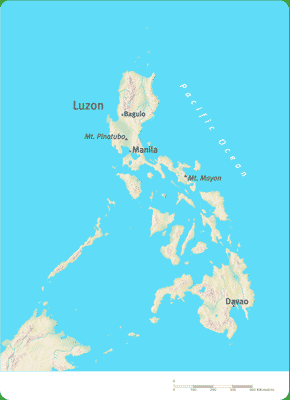
Natural Ingredients
Like most south-east Asian peoples, the Ifugao's staple food
is rice. The climate of northern Luzon lends itself well to
growing rice. Two distinct rainy seasons bring enough water
to flood and irrigate the padis, and long hours of tropical
sunshine help to make the rice plants grow and ripen. Meanwhile,
the soil is enriched by volcanic rock, deposited river sediment,
and nutrients from rotting forest leaves.
Terraces, Dykes and Drains
Despite these natural benefits, the mountain slopes are
very steep, making it very difficult to grow anything.
To overcome this, the Ifugao carved terraces of rice padis
creating a vast amphitheatre. The terraces, like giant
steps into the mountains, are divided by stone dykes (walls).
Some of these dykes are as high as twenty metres. If these
terraces were joined end to end, they would circle half
the Earth. |
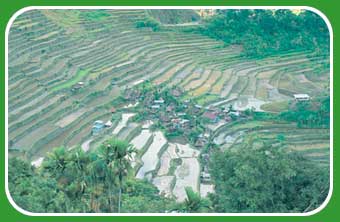
�Jeremy Horner/Panos
Pictures. |
But this is not as easy
as it sounds. To control the flow of water from one padi to
another, the Ifugao have built a complex system of irrigation
channels and bamboo pipes that take water from the nearby river
and criss-cross the terraces. Drains supplying water from one
terrace to the next are opened or closed depending on the water
requirements of different padis. Meanwhile, the Ifugao have
to work hard to carefully maintain the dykes to prevent them
from eroding or even collapsing.
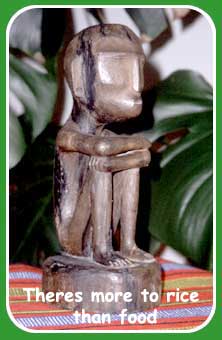 |
The
Ifugao cannot live on rice alone. To ensure that they
have a balanced diet, their gardens are filled with fruit
trees, and the rich volcanic soil enables them to grow
root crops like potatoes to the size of pumpkins. The
Ifugao also rear chickens and goats, whose nimble feet
can negotiate the area's steep slopes. |
The System under Pressure
Thanks to the fertile soil, the Ifugao rice farmers do not
need to buy artificial fertilisers, but the growth in the
population is putting this organic form of farming under stress.
In the past, an Ifugao family might own a whole terrace. Today,
these terraces are sub-divided between sons as they inherit
land from their father, a process known as 'fragmentation'.
This is particularly a problem for the poorer families who
own the steeper, narrower terraces.
| Mechanisation
and the use of water buffalo to pull a plough would help
Ifugao farmers produce more from these smaller plots of
land, but the terraces are too narrow and steep. |
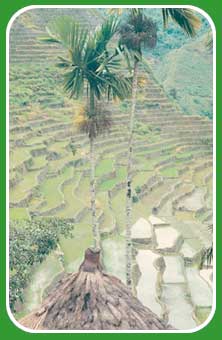 �Simon
Scoones/Worldaware.
�Simon
Scoones/Worldaware. |
The traditional rice
varieties used by the Ifugao also present problems as they
can only produce one harvest a year. Their tall stems are
vulnerable to the fierce winds brought by typhoons which cross
the region from time to time, and in recent years, changes
in global climate patterns have brought extended hot and dry
spells to the area, leaving the rice crop wilted and parched.
In other areas, farmers use the shorter higher yielding varieties
(HYVs) of rice that were developed during the Green Revolution
in the 1960s and 1970s. They can withstand a battering from
typhoon winds, and HYVs can generate two or even three harvests
a year. However, the irrigation system developed by the Ifugao
does not suit HYV rice.
Other natural threats
cause problems for the Ifugao. Thumb-sized earthworms that
can be one metre long bore holes into the soil and terrace
walls, causing water to seep out of the padi fields. Earthquakes
can cause structural damage to the dykes too.
An Uncertain Future
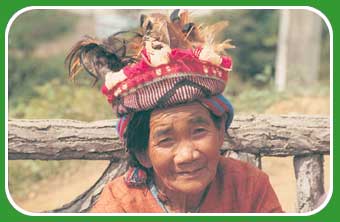 For
many of the younger Ifugao, the towns and cities appear
to offer work opportunities that are less back-breaking
and more financially rewarding. As a result, many have
chosen to move to Baguio, northern Luzon's largest city,
or even venture further south to the capital city of Manila.
The drift to urban areas of many of the younger generation
means that the Ifugao population in the highlands is ageing.
There is a danger that their skills and knowledge passed
by word of mouth over generations may be lost. For
many of the younger Ifugao, the towns and cities appear
to offer work opportunities that are less back-breaking
and more financially rewarding. As a result, many have
chosen to move to Baguio, northern Luzon's largest city,
or even venture further south to the capital city of Manila.
The drift to urban areas of many of the younger generation
means that the Ifugao population in the highlands is ageing.
There is a danger that their skills and knowledge passed
by word of mouth over generations may be lost. |
Although it has provided
food for thousands of years, the sustainability of the Ifugao's
farm system in the future is in question...
For more information on the Ifugao and a range of maps of The
Philippines, visit www.ifugaos.org/ifugao.htm
|
� |





